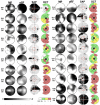Visual Field Reconstruction Using fMRI-Based Techniques
- PMID: 33520421
- PMCID: PMC7814355
- DOI: 10.1167/tvst.10.1.25
Visual Field Reconstruction Using fMRI-Based Techniques
Abstract
Purpose: To evaluate the accuracy and reliability of functional magnetic resonance imaging (fMRI)-based techniques to assess the integrity of the visual field (VF).
Methods: We combined 3T fMRI and neurocomputational models, that is, conventional population receptive field (pRF) mapping and a new advanced pRF framework "microprobing" (MP), to reconstruct the VF representations of different cortical areas. To demonstrate their scope, both approaches were applied in healthy participants with simulated scotomas and participants with glaucoma. For the latter group we compared the VFs obtained with standard automated perimetry (SAP) and via fMRI.
Results: Using SS, we found that the fMRI-based techniques can detect absolute defects in VFs that are larger than 3°, in single participants, based on 12 minutes of fMRI scan time. Moreover, we found that the MP approach results in a less biased estimation of the preserved VF. In participants with glaucoma, we found that fMRI-based VF reconstruction detected VF defects with a correspondence to SAP that was decent, reflected by the positive correlation between fMRI-based sampling density and SAP-based contrast sensitivity loss (SAP) r2 = 0.44, P = 0.0002. This correlation was higher for MP compared to that for the conventional pRF analysis.
Conclusions: The fMRI-based reconstruction of the VF enables the evaluation of vision loss and provides useful details on the properties of the visual cortex.
Translational relevance: The fMRI-based VF reconstruction provides an objective alternative to detect VF defects. It may either complement SAP or could provide VF information in patients unable to perform SAP.
Keywords: computational modeling; fMRI; glaucoma; receptive field; visual field mapping.
Copyright 2021 The Authors.
Conflict of interest statement
Disclosure: J. Carvalho, None; A. Invernizzi, None; J. Martins, None; N.M. Jansonius, None; R.J. Renken, None; F.W. Cornelissen, None
Figures









References
-
- Salvetat ML, Zeppieri M, Tosoni C, Parisi L, Brusini P.. Non-conventional perimetric methods in the detection of early glaucomatous functional damage. Eye. 2010; 24(5): 835–842. - PubMed
-
- Johnson CA. Visual fields: visual field test strategies. In: Giaconi J, Law S, Nouri-Mahdavi K, Coleman A, Caprioli J, eds. Pearls of glaucoma management. Heidelberg: Springer-Verlag; 2010: 123–128.
-
- Montolio FGJ, Junoy Montolio FG, Wesselink C, Gordijn M, Jansonius NM. Factors that influence standard automated perimetry test results in glaucoma: test reliability, technician experience, time of day, and season. Invest Opthalmol Vis Sci. 2012; 53(11): 7010. - PubMed
-
- Castro DPE, Kawase J, Melo LAS Jr.. Learning effect of standard automated perimetry in healthy individuals. Arq Bras Oftalmol. 2008; 71(4): 523–528. - PubMed
Publication types
MeSH terms
LinkOut - more resources
Full Text Sources
Other Literature Sources
Medical
Miscellaneous

